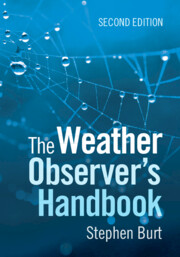61 results

The Weather Observer's Handbook
- Coming soon
-
- Expected online publication date:
- April 2024
- Print publication:
- 25 April 2024
-
- Book
- Export citation
12 - In Praise of Meteorology Field Courses
- from Part II - Essays: Inspiring Fieldwork
-
-
- Book:
- Curious about Nature
- Published online:
- 11 February 2020
- Print publication:
- 20 February 2020, pp 161-164
-
- Chapter
- Export citation
10 - Postcolonial Poetry and Form
- from Part II - Styles
-
-
- Book:
- The Cambridge Companion to Postcolonial Poetry
- Published online:
- 24 March 2017
- Print publication:
- 27 February 2017, pp 139-152
-
- Chapter
- Export citation
Measuring and Explaining the Decline in U.S. Cotton Productivity Growth
-
- Journal:
- Journal of Agricultural and Applied Economics / Volume 23 / Issue 1 / July 1991
- Published online by Cambridge University Press:
- 08 February 2017, pp. 105-120
-
- Article
- Export citation
Chapter 33 - The Exotic
- from Part VI - Social, Cultural, and Political Contexts
-
-
- Book:
- Wallace Stevens in Context
- Published online:
- 09 February 2017
- Print publication:
- 22 December 2016, pp 316-325
-
- Chapter
- Export citation
10 - Mid-Century Modernism
-
-
- Book:
- The Cambridge Companion to Modern American Poetry
- Published online:
- 05 December 2014
- Print publication:
- 19 January 2015, pp 128-142
-
- Chapter
- Export citation
Notes on Contributors
-
-
- Book:
- The Cambridge Companion to Modern American Poetry
- Published online:
- 05 December 2014
- Print publication:
- 19 January 2015, pp xi-xiv
-
- Chapter
- Export citation
Contents
-
- Book:
- The Cambridge History of American Poetry
- Published online:
- 05 December 2014
- Print publication:
- 27 October 2014, pp v-x
-
- Chapter
- Export citation
Chapter 50 - American Poetry at the End of the Millennium
- from Part IV - Beyond Modernism: American Poetry, 1950–2000
-
-
- Book:
- The Cambridge History of American Poetry
- Published online:
- 05 December 2014
- Print publication:
- 27 October 2014, pp 1144-1166
-
- Chapter
- Export citation
Part IV - Beyond Modernism: American Poetry, 1950–2000
-
- Book:
- The Cambridge History of American Poetry
- Published online:
- 05 December 2014
- Print publication:
- 27 October 2014, pp 821-1166
-
- Chapter
- Export citation
Introduction
-
-
- Book:
- The Cambridge History of American Poetry
- Published online:
- 05 December 2014
- Print publication:
- 27 October 2014, pp 1-12
-
- Chapter
- Export citation
Copyright page
-
- Book:
- The Cambridge History of American Poetry
- Published online:
- 05 December 2014
- Print publication:
- 27 October 2014, pp iv-iv
-
- Chapter
- Export citation
The Cambridge History of American Poetry - Half title page
-
- Book:
- The Cambridge History of American Poetry
- Published online:
- 05 December 2014
- Print publication:
- 27 October 2014, pp i-ii
-
- Chapter
- Export citation
Acknowledgments
-
- Book:
- The Cambridge History of American Poetry
- Published online:
- 05 December 2014
- Print publication:
- 27 October 2014, pp xix-xx
-
- Chapter
- Export citation
Index
-
- Book:
- The Cambridge History of American Poetry
- Published online:
- 05 December 2014
- Print publication:
- 27 October 2014, pp 1197-1306
-
- Chapter
- Export citation
Part I - Beginnings: Poetry before 1800
-
- Book:
- The Cambridge History of American Poetry
- Published online:
- 05 December 2014
- Print publication:
- 27 October 2014, pp 13-152
-
- Chapter
- Export citation
Part II - A New Nation: Poetry from 1800 to 1900
-
- Book:
- The Cambridge History of American Poetry
- Published online:
- 05 December 2014
- Print publication:
- 27 October 2014, pp 153-494
-
- Chapter
- Export citation
Selected Bibliographies
-
- Book:
- The Cambridge History of American Poetry
- Published online:
- 05 December 2014
- Print publication:
- 27 October 2014, pp 1167-1196
-
- Chapter
- Export citation
The Cambridge History of American Poetry - Title page
-
-
- Book:
- The Cambridge History of American Poetry
- Published online:
- 05 December 2014
- Print publication:
- 27 October 2014, pp iii-iii
-
- Chapter
- Export citation
Notes on Contributors
-
-
- Book:
- The Cambridge History of American Poetry
- Published online:
- 05 December 2014
- Print publication:
- 27 October 2014, pp xi-xviii
-
- Chapter
- Export citation



